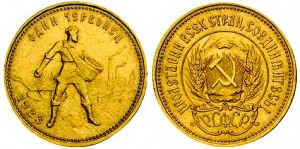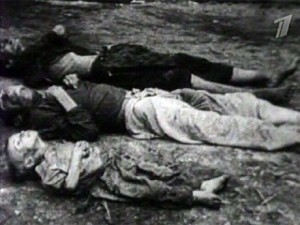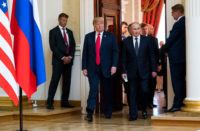The theory of the Holodomor is reactivated in the media every time Ukraine is about to take a step back to Russia. Just to remind those who are not aware of the tragedy, in 1932-1933 there was a severe famine throughout the USSR that claimed an unprecedented number of lives (up to 7 million victims, according to some debatable estimates). Paradoxically the famine mostly affected fertile areas in the North Caucasus, the Volga basin, the South Urals, Western Siberia, Ukraine, Belorussia and Kazakhstan. During the last decade several Western historians were recruited to elaborate on the theory that the famine tragedy was a deliberate act of genocide against Ukrainians carried out by Stalin’s government. Let’s consider the historical facts and try to get closer to the truth regarding the issue of the sources and circumstances of that horrible famine in the USSR.
First of all we have to recall something about the Gold, which surprisingly not always is a mean of payment…
In early 1920s the recently proclaimed Soviet Union was anxious about restoration of its industry totally destroyed after WWI and Civil War in Russia (1918-1921). The Soviets desperately needed modern machinery and industrial equipment. How could they pay it? Soviet government was able to offer to the international market three items: grain, minerals and gold.

On Genoa Conference in 1922 the new Gold Exchange Standard was introduced. Since the end of 1922 the Soviet Union was issuing the golden chervonets – a new Soviet currency fully covered by the golden reserves and convertible to gold. In 1923 the Soviet chervonets was one of the most stable and secured currencies of the world. It represented a clear and present danger for emerging financial epicentre – the United States of America The economic and financial weight of the United States boomed astonishingly as the result of global war. That country was one of few beneficiaries of the man-slaughtering house in Europe of 1910s. But an unexpected rival from the Bolshevik stated emerged vigorously…
In 1924 the Soviet chervonets was replaced by a softer rouble without golden equivalent. The menace to the US dollar and British pound was diminished. In return Soviet Union was recognized by the UK, France, Norway, Austria, Greece, Sweden, Denmark, China, Japan, Mexico and other countries. The United States possessed 46% of golden reserves of the capitalist world.
In 1925 the Soviet leadership decided to accelerate industrialization of the country. Quite surprisingly despite enormous economic gains promised by such policies, the Western countries refused to accept gold as payment when trading with Soviet Union! This amazing behaviour of is known in history as the “gold blockade”. The USSR could pay for machinery and equipment only by oil, timber and grains. (Interestingly, they still accepted pre-revolution Imperial Russian golden coins – the currency of a non-existent state was not dangerous!)
In 1929 the US bankers initiate the Great Depression. The short period of international currency exchange stability was over.
In 1931 Germany and Austria failed to repay the foreign debt and stop exchanging marks into gold, thus abolishing Gold Exchange Standard. By the autumn 1931 the UK suspends the gold exchange as well.
As you see, it would be a logical and natural move to lift the golden blockade of Soviet Union at that time, thus allowing Soviet gold to relieve the suffocating Western economies. But the decision they was taken at that circumstances was shocking in its absurdity. They not only left the gold blockade of the USSR in force, but also imposed a severe trade embargo on the major part of Soviet export! It was done despite acute economic crisis in the West where most producers were interested in any kind of demand, especially paid by gold, timber, oil and other raw material from the Soviet Union. E.g. in 1932 80% of British machinery export was being supplied to the USSR. Nevertheless, on April 17, 1933 the British government introduced embargo: Russian Goods (Import Prohibition) Act 1933! What was the logic? It was a politically motivated decision to pressure the tenacious Soviet government powered by the antagonistic ideology and economic structure.
Was the traded between the West and the USSR totally cut down? Absolutely not. Soviet demand for Western technologies and machinery was even higher than ever: the industrialization was full-pelt. But now the West was expecting only one mean of payment: the Soviet grains! (The curiosity of this claim is emphasized by the fact that by that time the currencies of the most agrarian countries were significantly devaluated and the demand for grains on world market was cut 50-70%!)
The Stalin’s government was faced with a choice: either to give up restoring industry, so capitulating to the West, or continue industrialising, leading to a dreadful internal crisis. If the Bolsheviks took grain away from the peasants, there was the very great probability of a famine which, in turn, might lead to internal unrest and removal from power. So no matter what Stalin chose, the West would remain victorious. Stalin and his entourage decided to force their way through and stop at nothing.
The government collected grain and sent it to the West, but not to starve part of a country’s population to death, but because there was no other way it could pay for the supply of equipment. All of Stalin’s hopes were on a new harvest. It turned out to be a small one, however, since the country was struck by a drought. The USSR was unable to buy food in exchange for gold (the gold blockade) or currency (as a result of the embargo there was none). Attempts were urgently made to get supplies of grain from Persia, where they had agreed to accept gold. The authorities did not have time, however, as a catastrophe was already underway.

Between 1932 and 1933, thousands and thousands of people died and it was only after this that the West was once again renewed to accept oil, timber and precious metals from the Soviets.
In October 2008, the European Parliament recognised the Holodomor in the Ukraine as a crime against humanity. The guilty was put on the ‘Stalinist USSR’. However, the report by the European Parliament did not provide answers to two questions:
• why did the capitalists behave so “strangely”, refusing to accept Stalin’s gold?
• why did they only want to receive grain from the USSR as payment?
There is neither truth nor logic in the European Parliament’s reports. The truth is that in 1934, grain exports from the USSR completely stopped. By order of the Soviet government…
The famine of 1932-33, which was carefully organized by the West, did not have the desired effect: the Bolsheviks remained in power. They continued industrializing. Economic measures had no effect – Stalin was restoring the country at any price. Only military measures remained. And exactly in 1933 Adolf Hitler, who had openly written about his expansionist aims in the vast Russian plains, came to power in Germany…
The publication is based on a chapter from the book by Nikolay Starikov “Crisis. How It Is Being Done”, released in 2011.
PREVIOUS EPISODES
Episode 9. How the British “Liberated” Greece
Episode 7. Britain and France Planned to Assault Soviet Union in 1940
Episode 6. Leon Trotsky, Father of German Nazism
Episode 5. Who paid for World War II?
Episode 4. Who ignited First World War?
Episode 3. Assassination in Sarajevo














Pingback: Episode 11. A Soviet Quarter Century (1930-1955) | Oriental Review
Is there any verification about the gold story, facts, export figures, documents?
UK’s Gold Standard Act 1925 established a new procedure for buy-sell operations with gold. The Russian gold coins issued after 1914 ceased to be accepted by the Bank of England. For Soviet grain export chart see e.g. “The Economic Transformation of the Soviet Union, 1913-1945” by R. W. Davies, Mark Harrison, S. G. Wheatcroft, p.204.
Pingback: Vatican clergy and Ukrainian nationalism (II) | Oriental Review
Pingback: Vatican clergy and Ukrainian nationalism (II)
Pingback: Episode 16. Who signed the death sentence for France in 1940? (I) | Oriental Review
Pingback: Churchill envisioned attacking the USSR at the end of World War Two
Pingback: Qui a organisé la Famine de 1932-1933 en URSS ? | Réseau International
Pingback: Who Organised the Famine in the USSR in 1932-1933? | Réseau International (english)
Pingback: Les Dessous du génocide ukrainien Holodomor | L'Amer Dessous Des Cartes
Pingback: Episode 17. Britain – Adolf Hitler’s star-crossed love (III) | Oriental Review
Pingback: Episode 14. How Adolf Hitler turned to be a “defiant aggressor” (I) | WiseTheDome
Pingback: Add a Cup of Crocodile Tears: “Western Values” is a Myth | The Kremlin Stooge
Pingback: What Is The Ukraine Famine – International Ask
Pingback: Epizoda 10. Kdo zorganizoval hladomor v SSSR v letech 1932-1933? – Nová republika
Pingback: NATO’s yearning for the East | Oriental Review
Pingback: Vatican Clergy And Ukrainian Nationalism | The GLOBAL POLITICS
Pingback: Holodomor, what it is (and why it’s fake) | ML-Theory
Pingback: Episode 17. Britain – Adolf Hitler’s star-crossed love (III) – OrientalReview.org
Gold itself especially during the famine turned into a very important export of the soviet union that they skimmed off from the farmers who were starving in the Ukraine. They then traded this gold to the Germans for tractors. Gold itself shockingly was an unlisted export:
“The Soviet Union achieved some success in its efforts to increase industrial exports. Gold exports, which do not form part of the published statistics, were somewhat lower than in the previous year; but still exceeded gold production. Great efforts were also made to sell antiques and works of art abroad, with only a small effect on the balance of payments. Greater Success was achieved with manufactured goods and raw materials. The Soviet Union produced textiles lengths, metal goods, china and glass at special enterprises earmarked for export, and exports of all these items increased in 1932.”
(Source: The Industrialization of Soviet Russia Volume 4, Davies, p.315)
Gold production during these years actually increased, it actually makes little sense for the Soviets to have done such if they couldn’t export gold.
Pingback: Episode 18. How Britain assisted the Soviet Union’s fight against Hitler (I) – OrientalReview.org
Pingback: Episode 20. Who put up the Berlin Wall? | OrientalReview.org
Pingback: Capitalism versus Communism (By Ozgur Zeren.) | maddoctordethrow
Pingback: The Holodomor – Voices Of The Revolution
Pingback: The Holodomor Story – Kópamaros
Pingback: Les banquiers et les soviets – RegnumGalliaeRegnumMariae
Pingback: The Soviet famine of 1932-33 – Lyle Hausman
Pingback: Mit głodu w Ukrainie - IKM-CMAP